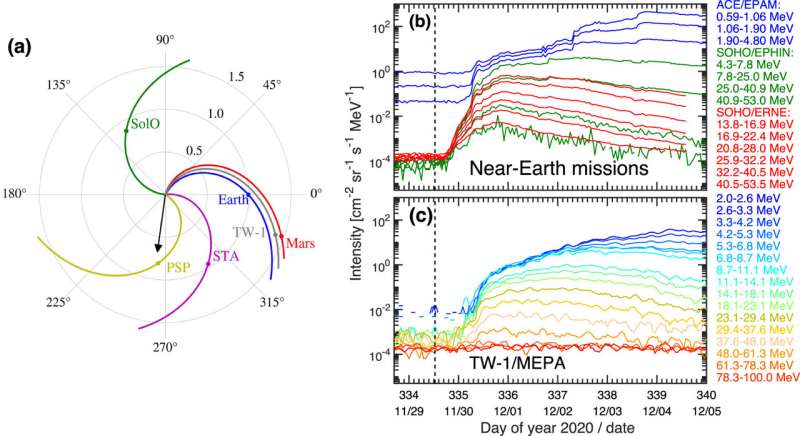Researchers report solar energetic particle event observed by China's Tianwen-1 mission

Researchers from the Institute of Modern Physics (IMP) of the Chinese Academy of Sciences (CAS) and their collaborators have reported a solar energetic particle (SEP) event observed by the Mars Energetic Particle Analyzer (MEPA) carried on China's Tianwen-1 (TW-1) spacecraft. As the first scientific report based on MEPA, the paper was published in the Astrophysical Journal Letters.
MEPA, jointly developed by IMP and the Lanzhou Institute of Physics, is the first scientific payload of China aimed at studying the interplanetary and near-Mars space radiation environment. It was launched with the TW-1 spacecraft in July, 2020 to start exploration mission.
On November 29, 2020, MEPA observed the first large widespread SEP event of solar Cycle 25 at 1.39 astronomical unit. At the time of eruption of the SEP event, TW-1 and Earth were approximately on the same magnetic field line, meaning that TW-1 and near-Earth spacecraft could observe solar energetic particles from a distance of tens of millions of kilometers, which provided a rare opportunity to study the effects of energetic particle propagation.
The study of the acceleration and propagation mechanism of solar energetic particles is of great importance in space physics. Once leaving the near-Earth environment and going into space, astronauts and spacecraft without the protection of the geomagnetic filed are inevitably exposed to intense high energy particle radiation. Unlike galactic cosmic rays whose flux is stable for a long time, SEP events are sporadic and unpredictable during any solar cycle. Their flux is several orders of magnitude higher than those of the background cosmic rays, which not only has a great impact on the interplanetary and near-earth space radiation environment, but will also pose a huge threat to space missions such as manned spaceflight and deep space exploration.
After obtaining the MEPA data, the researchers from IMP evaluated the data and confirmed that MEPA was in good working condition. Using their self-built MEPA simulation software, they compared the simulated data with the results of the sampled original data returned, and obtained the geometric factors of MEPA for different types of incident particles. The researchers also determined the relationship between the sampled original data and the observed on-orbit energy spectrum of MEPA, and established a set of MEPA data analysis methods to ensure the quality of the scientific detection data of MEPA.
Based on the proton flux data of MEPA and near-Earth satellites, the research team investigated the acceleration and propagation mechanism of the SEP events. The team consists of researchers from Macao University of Science and Technology, China University of Geosciences, IMP, Lanzhou Institute of Physics, University of Science and Technology of China of CAS, University of Alabama in Huntsville, U.S., and National Space Science Center of CAS.
By comparing the proton flux data from MEPA and near-Earth spacecraft, the researchers found that the magnetic field line associated with TW-1 and near-Earth spacecraft is not connected to burst source regions on the sun's surface and interplanetary shock, which means that the observation by TW-1 and near-Earth spacecraft is due to cross-field diffusion.
Meanwhile, the researchers found that the data at the two locations showed similar double-power law spectral characteristics and the proton time-intensity profiles showed a typical reservoir phenomenon during the SEP decay phase. They suggested that the double-power-law spectrum is most likely generated in the source region of the shock acceleration, and vertical diffusion is a key factor in explaining the SEP reservoir phenomenon during this event. They also discussed the radial and interplanetary magnetic field path-length dependence of SEP peak intensity.
The SEP event shows very good consistency between the observation data of MEPA and near-Earth satellites. The result lays a good foundation for the subsequent study of the near-Mars exploration data and will help people better understand the radiation environment on Mars and plan deep space exploration missions.
More information: Shuai Fu et al, First Report of a Solar Energetic Particle Event Observed by China's Tianwen-1 Mission in Transit to Mars, The Astrophysical Journal Letters (2022). DOI: 10.3847/2041-8213/ac80f5
Journal information: Astrophysical Journal Letters
Provided by Chinese Academy of Sciences




















